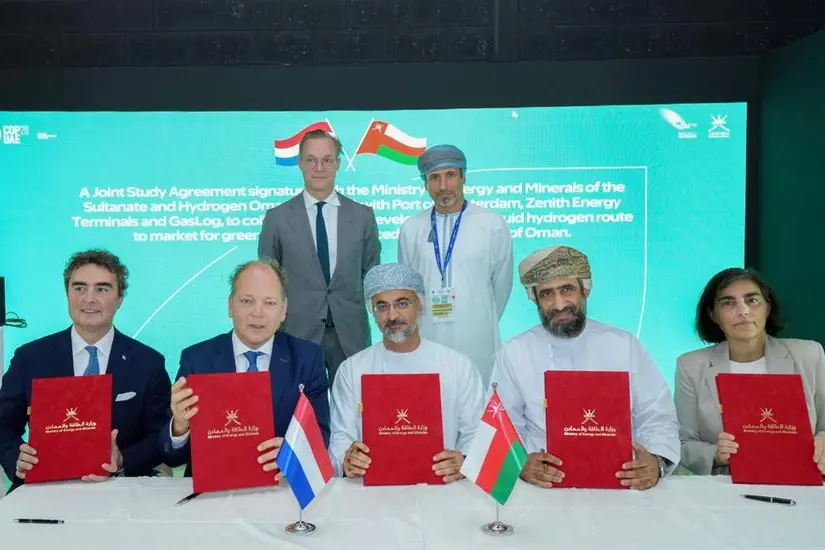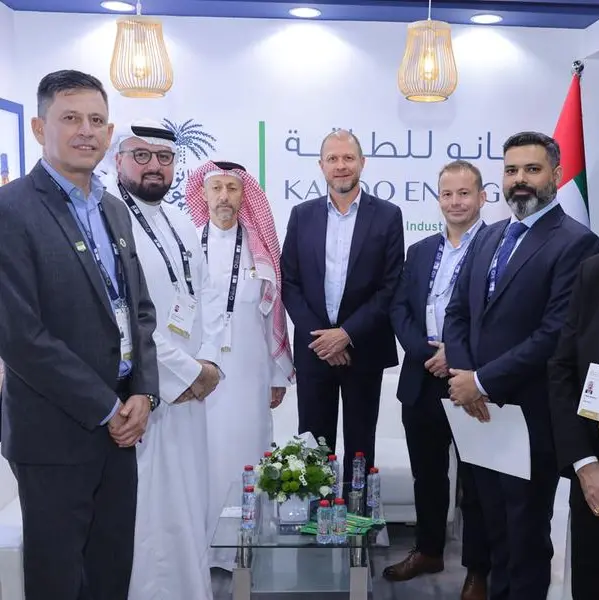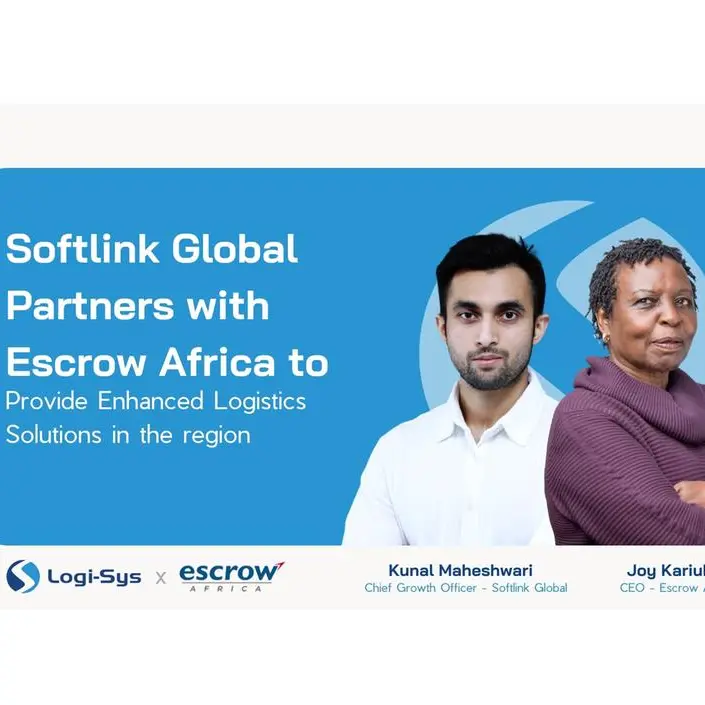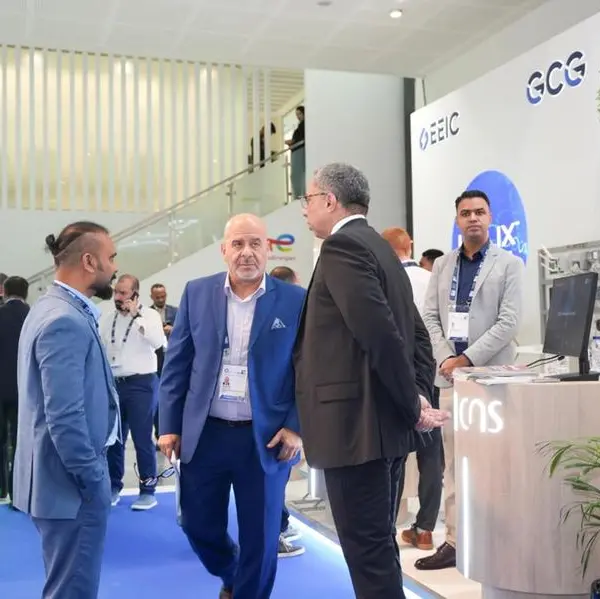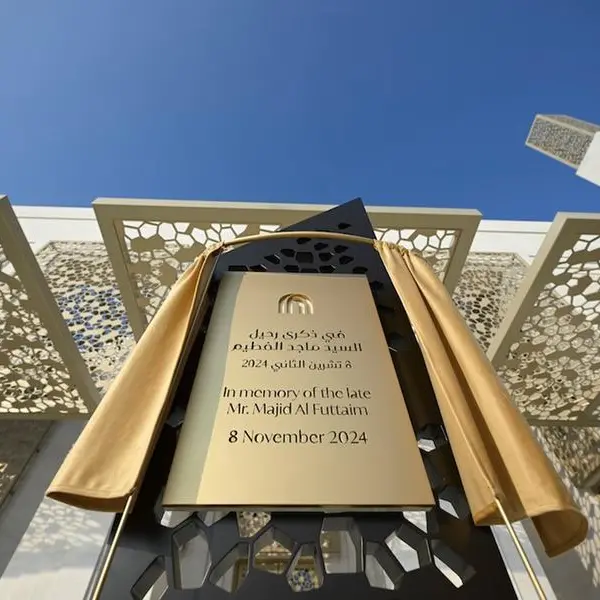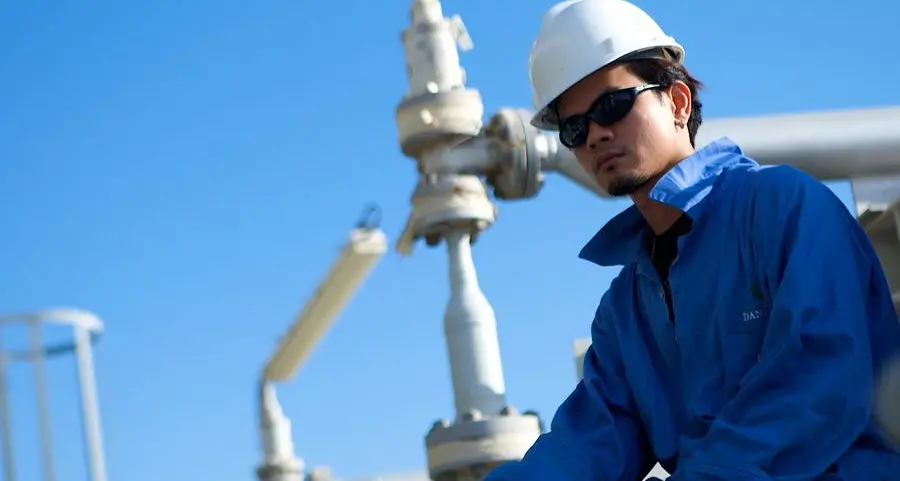PHOTO
- The Government of Oman, Hydrogen Oman (Hydrom), Port of Amsterdam, Zenith Energy Terminals and GasLog agree to study the development of a liquid hydrogen supply chain, to deliver Omani green hydrogen to the Port of Amsterdam and onwards to Europe.
Dubai: The Sultanate of Oman’s Ministry of Energy and Minerals and Hydrogen Oman (Hydrom) have signed a Joint Study Agreement (JSA) with Port of Amsterdam, Zenith Energy Terminals and GasLog, to collaborate on the development of a liquid hydrogen route to market for green hydrogen produced in the Sultanate of Oman.
The Agreement underscores the clear ambitions of the partners to make the world’s first commercial scale liquid hydrogen corridor a reality. The Agreement was signed at the Omani Pavilion during COP28 in Dubai, with His Excellency the Minister Eng. Salim bin Nasser Al Aufi and the Climate Envoy of the Kingdom of the Netherlands, Prince Jaime de Bourbon de Parme, as official witnesses of the ceremony.
The Agreement entails conducting a detailed assessment of the requirements to develop an open-access hydrogen liquefaction, storage and export facility in the Sultanate of Oman, along with the provision of specialised vessels for the transportation of the liquid hydrogen, currently under development by GasLog. The primary aim of the Agreement is to establish a green hydrogen corridor between the Sultanate of Oman and the Netherlands, with the terminal of Zenith Energy as the destination for the import, regasification and further distribution of Oman-produced hydrogen to both local offtakers within the port of Amsterdam, as well as large industries in the European hinterland. The open-access liquefaction facility will also enable the government of the Sultanate of Oman to explore cost effective hydrogen export corridors to other global markets.
Guided by Oman’s Vision 2040, which is anchored on diversifying its economy away from oil and gas, as well as the country’s long-term goal to reach Net-Zero by 2050, the government of the Sultanate of Oman has pursued a hydrogen strategy that seeks to capitalise on the country’s abundant (wind and sun) natural resources and existing port and industrial infrastructures. Moreover, its geographical location puts Oman in a prime position to supply the European and the Asian markets. Hydrom is orchestrating the overall development of the Omani hydrogen sector and is responsible for master-planning, managing the allocation of government lands to hydrogen developers and overseeing the execution of projects. The open-access facility for liquefaction would unlock great potential for these projects, offering liquid hydrogen as a viable vector that can be utilised by individual projects for export.
“As countries around the world race to achieve a hydrogen-based economy, the fundamental challenges of storing and transporting hydrogen on large scale remain open,” said Abdulaziz Al Shidhani, Managing Director of Hydrom. “Oman is building an economically sustainable future by establishing a fully integrated hydrogen ecosystem. This joining of efforts with the Port of Amsterdam, Zenith Energy Terminals and GasLog will help bring us one step closer to our shared goal.”
The strong potential of the Sultanate of Oman and the unique position of the Netherlands as a gateway to the European market, has led to an earlier agreement between the two nations. The MoU, which was signed during COP28, aims to advance the bilateral collaboration to support companies to establish import and export corridors, as well as to strengthen cooperation and investment opportunities within import and export facilities for clean and locally produced hydrogen. The Agreement signed at this year’s edition of COP28 constitutes a new milestone in Omani-Dutch relations, where the Omani government, Hydrom, Port of Amsterdam, Zenith Energy Terminals and GasLog will work on the realisation of the envisioned import/export corridor.
Dorine Bosman, Chief Investment Officer at Port of Amsterdam, said, “Both Oman and the Netherlands are clearly in the vanguard in the development of the global hydrogen market. The complementarity between both nations offers a strong foundation for a fruitful collaboration, as evidenced by the MoU signed by both governments during COP28. We are proud that Port of Amsterdam, together with Zenith Energy Terminals and GasLog, can now, at this year’s edition of COP28, take next steps towards the realisation of a liquid hydrogen corridor between the Sultanate and our port. Oman’s natural blessings and the leadership of its government on green hydrogen mean that the Omani Ministry of Energy and Minerals and Hydrom are fitting partners. We look forward to establishing the port of Amsterdam as the gateway for Omani-produced green hydrogen to the European market.”
Background: Moving Green Hydrogen as a Liquid.
Liquefying gaseous hydrogen, shipping of liquid hydrogen and regasification at the destination port is a mode of energy transportation successfully used by the LNG industry for decades. Leveraging the pioneering works undertaken by the ‘Hydrogen Energy Supply Chain Project’, which designed and built the Suiso Frontier, the world’s first liquid hydrogen vessel, the partners under this Agreement seek to develop an energy efficient and zero carbon emission, liquid hydrogen handling chain, which can safely, efficiently and cost effectively deliver commercial quantities of Oman’s green hydrogen to international markets well before 2030.
About Hydrom
Hydrom is a fully owned independent subsidiary of Energy Development Oman SAOC (EDO) and serves as the overall orchestrator and master planner of Oman’s green hydrogen sector. Its mandate includes setting the strategy and advising government on policies and legal framework for the hydrogen sector in addition to delineating government-owned lands earmarked for hydrogen. Hydrom is also responsible for the structuring of large-scale green hydrogen projects, managing the allocation process to developers, and facilitating the development of shared infrastructure and connected ecosystem industries and hubs. Through its role, Hydrom is advancing In-country Value by generating employment, expanding educational resources and developing localised supply chains and industry-adjacent opportunities across the value chain.
Media Contacts:
For media inquiries, please contact:
IDENTITY
latest@ouridentity.com
About Port of Amsterdam
Port of Amsterdam aims to be a leading European seaport at the forefront of the transition to a sustainable society. The port is a logistics hub for international and national trade flows, as well as local urban distribution. The port focuses on growth of bio- and synthetic fuels, hydrogen activities, circular industry and manufacturing. Western Europe's fourth port delivers added value by employing 68,000 people at port and port-related companies. By innovating, the port is working towards a smoother and more transparent shipping process and reduced CO2 emissions from port and shipping. Port of Amsterdam is working intensively with clients and partners to make the port operate faster, smarter and cleaner. So a little better every day.
For more information, please visit www.portofamsterdam.com
About Zenith Energy Terminals
Zenith Energy Terminals is a world-class midstream company that owns and operates over 3 million cubic metres of renewable fuels, crude oil, petroleum products, chemicals and gas storage across North American, Europe and Latin America through its subsidiaries Zenith International and Zenith Energy U.S. The Company’s focus is on building a sustainable, independent liquid storage terminals business that provides safe and reliable solutions for its customers in the years to come.
For more information, visit www.zenithterminals.com
About GasLog Ltd.
GasLog Ltd. (“GasLog”) is an international owner, operator and manager of LNG carriers providing support to international energy companies as part of their LNG logistics chain. GasLog’s consolidated fleet consists of 38 LNG carriers (33 on the water, four under construction and one vessel undergoing conversion into a floating storage and regasification unit, or “FSRU”). Of these vessels, 18 are owned by GasLog, six have been sold and leased back by GasLog under long-term bareboat charters and of the remaining 14 LNG carriers, 11 are owned by the Company’s subsidiary, GasLog Partners LP, and three have been sold and leased back by GasLog Partners LP.
